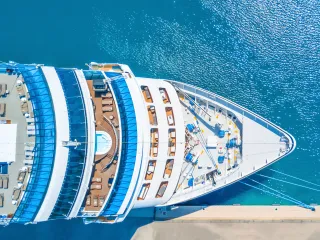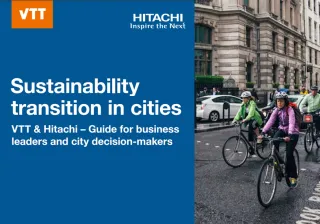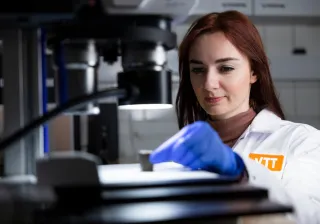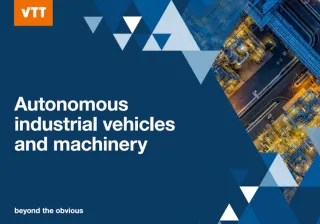Maritime traffic is a major source of emissions that cause global warming and bad air quality. Together with VTT, Valmet pilot tested the use of a marine scrubber and a wet electrostatic precipitator to reduce particle emissions from ships by up to 99 percent. The solution protects our planet and allows ship companies to comply with tightening regulation.
Key facts
Significant reduction in particle emissions from ships
Cheaper operating costs and branding boost for shipping companies
Valmet preparing a global go-to-market strategy for the solution
With a history of over 200 years, Valmet is a global developer and supplier of process technologies, automation and services for the pulp, paper, energy and marine industries. The company’s net sales in 2020 were approximately 3.7 billion euros. Valmet’s shares are listed on Nasdaq Helsinki.
Global maritime particle emission regulations just a matter of time
Maritime traffic is a major source of emissions. According to an International Maritime Organization study, it is responsible for around 2.9 percent of global greenhouse gas emissions. There is also a risk that shipping emissions will significantly increase.
This is why International Maritime Organization has set a goal to reduce total annual GHG emissions from international shipping by at least 50 percent by 2050. The European Union has already imposed regulations on CO2 emissions.
IMO’s regulations on air pollution, on the other hand, have so far addressed only SOx and NOx. Nevertheless, the awareness concerning particle and black carbon emissions is growing. Studies have shown that particle emissions can also influence climate and health.
Tightening regulation encourages shipping companies to create more environmentally friendly ships. To support this goal, Valmet started a project to reduce particle emissions in medium-speed ship engines with the combination of a closed loop marine scrubber and a wet electrostatic precipitator (WESP). Valmet’s ambitious target was to get below the emission levels of the Euro 6 standard, which regulates motor vehicles.
As the idea of installing both a scrubber and a WESP simultaneously was completely new, Valmet needed a partner to research, pilot test and configure the engine setup.

Successful pilot tests yield astonishing results in cutting emissions
The pilot testing and configuration project was a collaborative effort between Valmet and VTT. While Valmet provided the marine scrubber and the WESP, VTT had a suitable engine and the research equipment that could be used to validate how the installation affects emissions.
“VTT had a medium-speed diesel engine that runs on heavy fuel oil, the equipment for demanding pilot tests, top experts and the scientific know-how to publish the test results. This combination is very rare globally, which made it easy to choose VTT to validate and optimise the engine setup,” says Juha Jokiluoma, Product Manager at Valmet.
The installation proved to be challenging and required fast improvisation on a tight schedule. “VTT could really bring added value in the configuration of the equipment and fuel,” Jokiluoma elaborates.
After the engine setup was ready, VTT studied the emissions levels for:
- black carbon and particle number and size
- sulphur dioxide
- carbon dioxide.
Finally, the engine setup was validated for seaworthiness with an inclination test.
“At VTT, we had already studied the emissions of ships that have a marine scrubber installed. This way we had experience of the challenging measurement conditions related to scrubbers and also comparable data on the emission reduction potential of the new setup,” says VTT’s Senior Scientist Kati Lehtoranta.
After completing the testing and configuration phase, VTT started to prepare a scientific paper to publish the astonishing results of combining the marine scrubber and WESP:
- Particle emissions decreased by more than 98.5 percent, both in terms of number and size.
- Black carbon emissions decreased by 99 percent.
- The engine setup functioned perfectly in the inclination test.
“The engine setup that included the scrubber, the WESP and the measurement equipment was huge and required a lot of configuration. Especially the tilting process was delicate. But now we know that, along with reducing emissions, the scrubber and WESP function at sea,” Lehtoranta continues.
Clear benefits pave the way for a global go-to-market strategy
The successful reduction of emissions and the validation of seaworthiness enabled Valmet to start creating a global go-to-market strategy for their solution.
The environmental benefits of the project include smaller pollution levels and tackling global warming. However, using the marine scrubber and WESP together brings various benefits to shipping companies, too:
- Sustainable cruising: Customers are more interested in cruises that are environmentally friendly. The WESP also significantly reduces visible plumes, which is a straightforward indicator of sustainability.
- Routing: Low-emission ships can continue operation in vulnerable areas, as the air emissions are low.
- Efficiency: Ships with a scrubber and a WESP can use cheaper fuels and run their auxiliary engines to generate electricity when docked without having significant impact on ambient air quality.
- Compliance: The solution makes ships more compliant with emerging regulation.
- Versatility: The solution is not limited to a specific engine manufacturer or fuel and can thus be used with all ship engines.
“The solution brings so many benefits that we believe it has enormous business potential. Emission regulations are bound to tighten in the upcoming years. Valmet now has a solution that can be installed both on newbuilds and already operating vessels that still use conventional fuels. That enables shipping companies to significantly reduce particle emissions, while continuing their operation normally,” says Jokiluoma.
Expertise allows room for successful improvisation
Both VTT and Valmet are delighted with the project’s results. Even though the project was planned carefully before the experiments, ensuring a successful outcome required both organisations to work fast and improvise on the spot.
“The two biggest challenges were that the technology application was new and the schedule was tight. We are impressed with the flexibility and know-how of VTT’s experts. VTT listened to our requests and ideas patiently and came up with solutions proactively,” says Jokiluoma.
“Active and open communication was crucial in reacting to sudden changes during the project. Working with Valmet’s top professionals was a pleasure. There’s definitely potential for further maritime collaboration,” Lehtoranta concludes.







